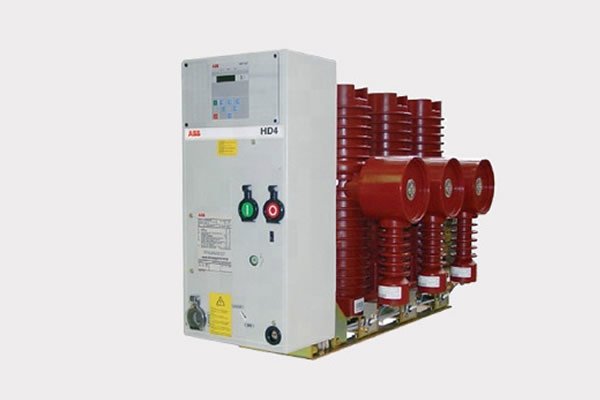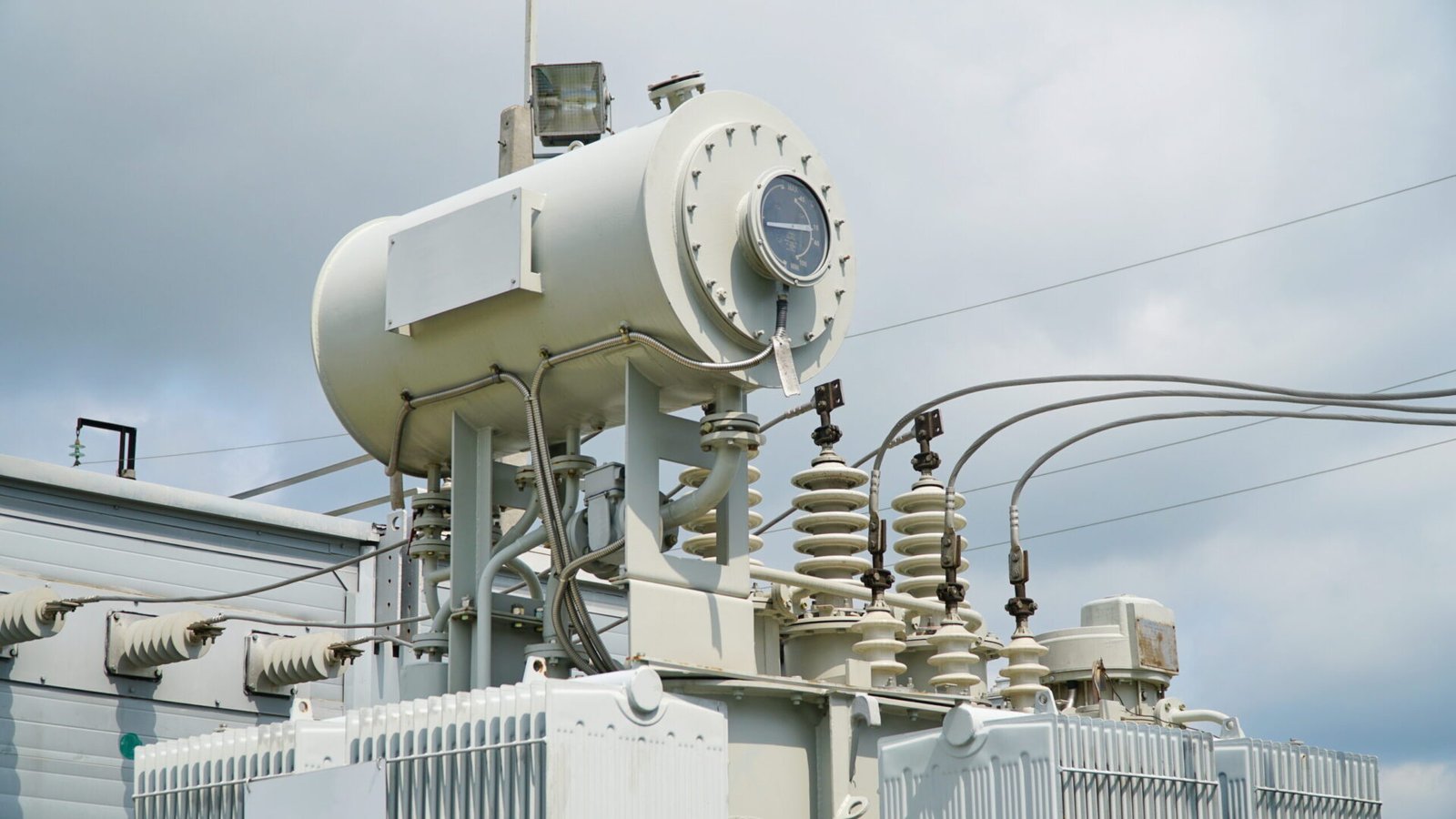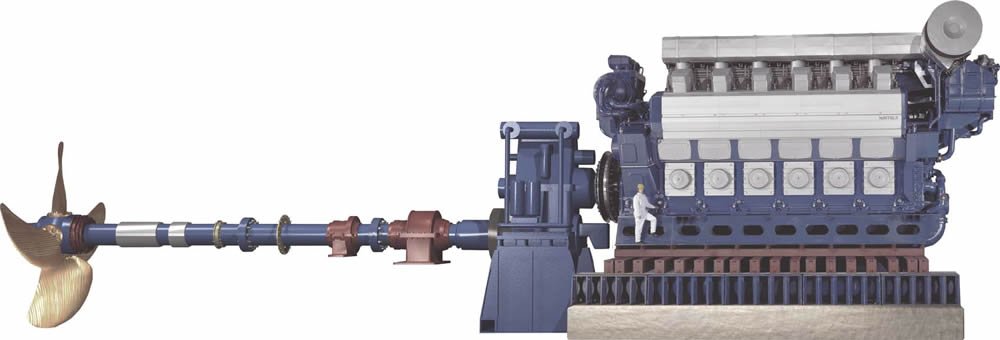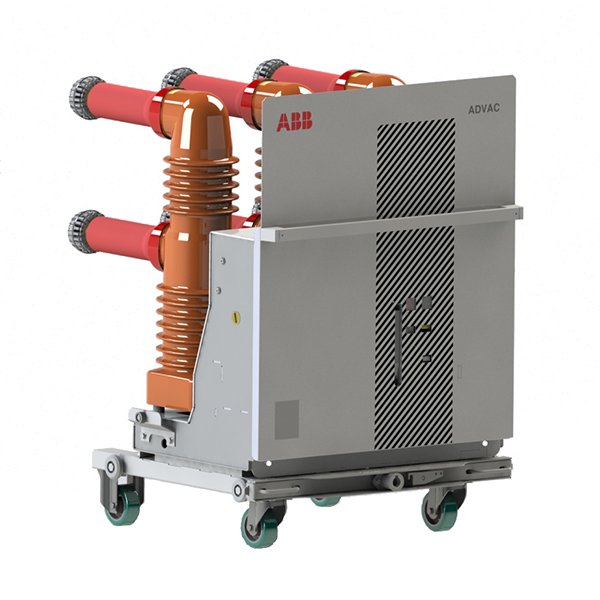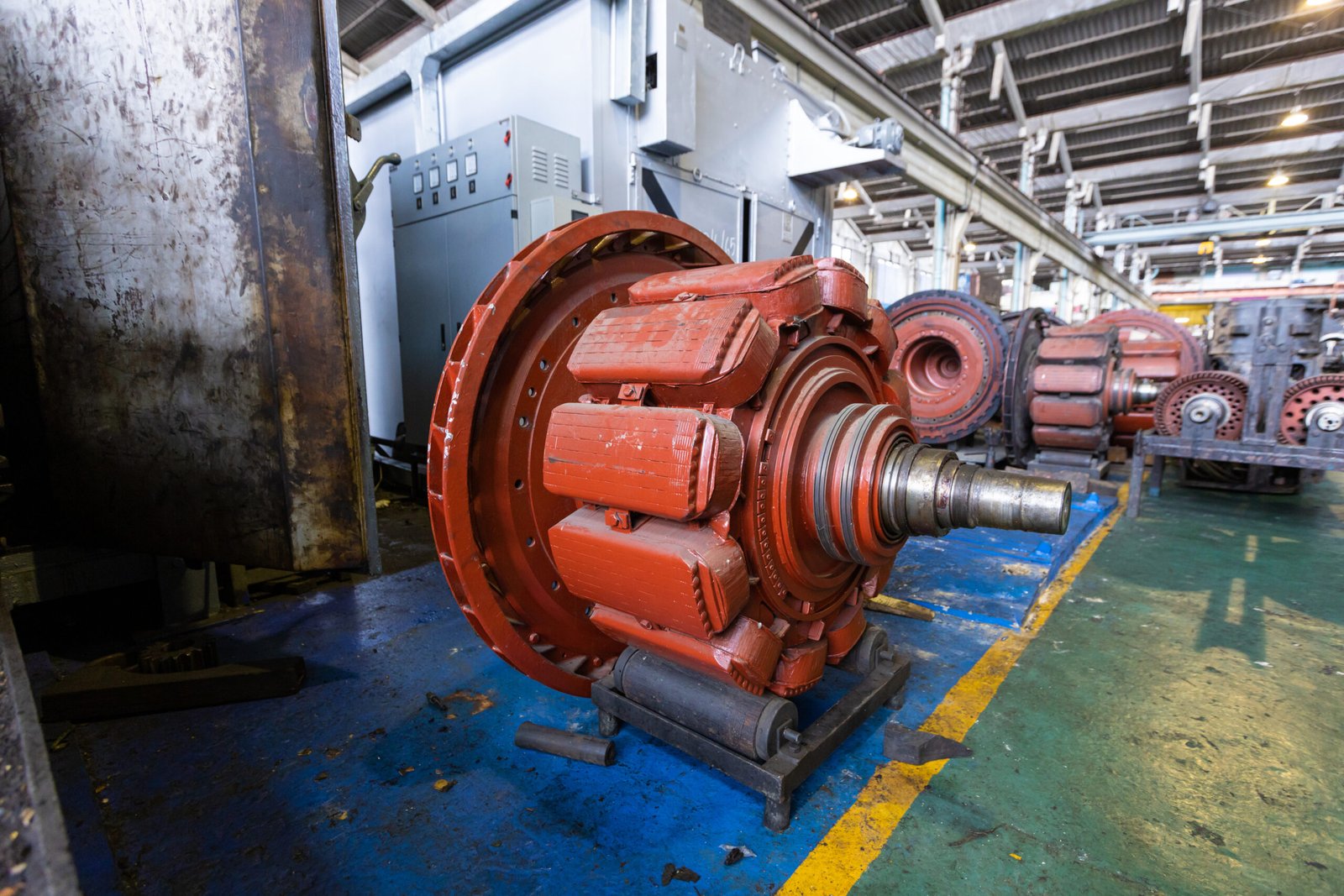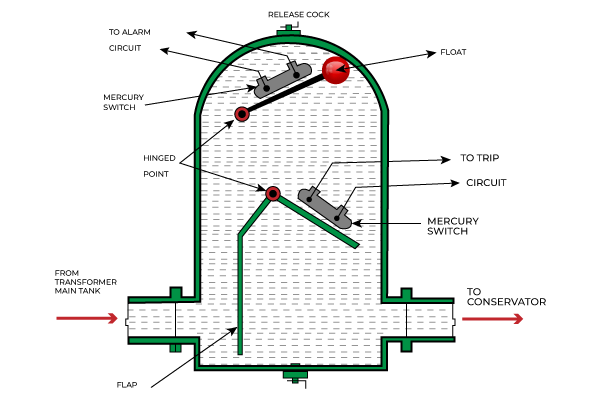Introduction
In today’s world, a reliable electrical system is essential for both residential and industrial applications. One of the critical components ensuring this reliability is the circuit breaker. Among the various types available, the SF6 circuit breaker stands out due to its unique properties and performance. This article aims to provide a detailed understanding of SF6 circuit breakers, their working principles, advantages, disadvantages, and applications. By the end, you will have a comprehensive knowledge of these devices and their significance in modern electrical systems.
What is an SF6 Circuit Breaker?
What is an SF6 Circuit Breaker?
An SF6 circuit breaker is a type of circuit breaker that uses sulfur hexafluoride (SF6) gas to extinguish the arc produced during the interruption of electrical currents. The SF6 gas has excellent insulating and arc-quenching properties, making it a popular choice for high-voltage applications. Unlike traditional circuit breakers that use oil or air, SF6 circuit breakers offer superior performance in terms of reliability and efficiency.
Comparison with Other Types of Circuit Breakers
SF6 vs. Air Circuit Breakers
SF6 circuit breakers are often compared to air circuit breakers. While air circuit breakers use air to extinguish the arc, SF6 circuit breakers use sulfur hexafluoride gas. The primary difference lies in their arc-quenching capabilities. SF6 gas has a higher dielectric strength, which means it can handle higher voltages more efficiently. This results in smaller and more compact designs, which is particularly useful in space-constrained environments.
SF6 vs. Oil Circuit Breakers
Oil circuit breakers, another alternative, use oil as the arc-extinguishing medium. While oil circuit breakers are effective, they require more maintenance and pose environmental risks due to potential oil leaks. In contrast, SF6 circuit breakers are virtually maintenance-free and environmentally safer, provided proper handling of the SF6 gas is ensured.
How Does an SF6 Circuit Breaker Work?
SF6 circuit breakers operate by utilizing the unique properties of sulfur hexafluoride gas to interrupt electrical currents. Understanding their components and working principles is essential to appreciate their efficiency and reliability.
Components of an SF6 Circuit Breaker
- Contacts: These are the points where the electrical current flows through. The contacts open to interrupt the current flow during a fault.
- Arc Extinguishing Chamber: This chamber contains the SF6 gas and is where the arc is extinguished.
- SF6 Gas: Sulfur hexafluoride gas, known for its high dielectric strength and thermal stability, is the key element in quenching the arc.
- Operating Mechanism: This mechanism controls the opening and closing of the contacts.
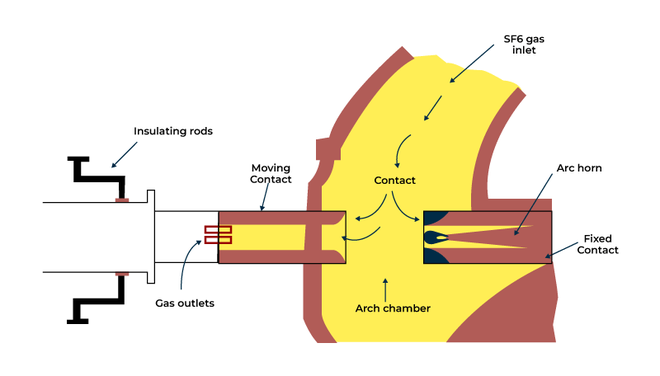
Working Principle
When a fault occurs in the electrical system, the contacts within the SF6 circuit breaker separate. This separation creates an electric arc between the contacts. The arc-extinguishing chamber, filled with SF6 gas, comes into play at this point. The high dielectric strength of SF6 gas allows it to withstand high voltages and effectively cools and extinguishes the arc. Here’s a step-by-step explanation of the process:
- Fault Detection: The system detects an abnormal current flow, indicating a fault.
- Contacts Separation: The contacts within the breaker begin to separate, creating an arc.
- Arc Formation: As the contacts open, an arc forms between them.
- Arc Quenching: The SF6 gas in the arc-extinguishing chamber cools the arc, reducing its temperature and energy.
- Current Interruption: The arc is extinguished, and the electrical current is interrupted, preventing damage to the system.
The efficiency of SF6 gas in quenching the arc quickly and effectively makes SF6 circuit breakers a reliable choice for high-voltage applications.
Advantages of SF6 Circuit Breakers
SF6 circuit breakers offer several benefits that make them superior to other types of circuit breakers, especially in high-voltage applications. Let’s explore these advantages in detail.
High Insulation and Arc Quenching Capabilities
Sulfur hexafluoride (SF6) gas is known for its exceptional insulating properties. It has a dielectric strength that is two to three times greater than air or other gases used in circuit breakers. This high dielectric strength allows SF6 circuit breakers to operate at higher voltages without the risk of electrical breakdown. Additionally, SF6 gas has excellent thermal stability, which means it can efficiently cool and extinguish the arc, ensuring the circuit breaker operates safely and reliably.
Low Maintenance Requirements
One of the significant advantages of SF6 circuit breakers is their low maintenance requirements. Unlike oil circuit breakers, which need regular oil changes and inspections, SF6 circuit breakers are virtually maintenance-free. The SF6 gas does not degrade over time, reducing the need for frequent maintenance. This makes SF6 circuit breakers a cost-effective solution in the long run, as they require fewer resources and less downtime for maintenance.
Compact Design
SF6 circuit breakers are designed to be compact and space-efficient. The high dielectric strength of SF6 gas allows for smaller and more compact designs compared to other types of circuit breakers. This is particularly beneficial in applications where space is limited, such as in urban substations or industrial plants. The compact design also makes installation easier and more cost-effective, as it requires less infrastructure and support.
Disadvantages and Environmental Impact
While SF6 circuit breakers offer numerous advantages, it is essential to consider their disadvantages and environmental impact.
Environmental Concerns
SF6 gas is a potent greenhouse gas with a global warming potential (GWP) that is 23,500 times greater than carbon dioxide. Although SF6 circuit breakers are highly efficient and reliable, their environmental impact cannot be ignored. The release of SF6 gas into the atmosphere can contribute significantly to global warming. It is crucial to handle SF6 gas carefully and implement measures to prevent leaks and minimize its environmental impact.
Mitigation Measures
To address the environmental concerns associated with SF6 gas, several mitigation measures can be implemented:
- Recycling and Reuse: SF6 gas can be recycled and reused in circuit breakers, reducing the need for new SF6 gas production and minimizing its environmental impact.
- Leak Detection Systems: Advanced leak detection systems can be installed to monitor and detect any SF6 gas leaks, allowing for immediate action to prevent further emissions.
- Alternative Technologies: Researchers and manufacturers are exploring alternative technologies that can replace SF6 gas in circuit breakers. These alternatives aim to provide similar performance without the environmental impact of SF6 gas.
By implementing these mitigation measures, the environmental impact of SF6 circuit breakers can be significantly reduced.
Applications of SF6 Circuit Breakers
SF6 circuit breakers are used in various applications due to their high performance and reliability. Here are some of the key applications:
Power Transmission and Distribution
SF6 circuit breakers are widely used in power transmission and distribution systems. They are commonly found in substations, where they play a crucial role in ensuring the safe and efficient operation of the electrical grid. The ability of SF6 circuit breakers to handle high voltages and interrupt large fault currents makes them ideal for this application.
Industrial Applications
In industrial settings, SF6 circuit breakers are used to protect heavy machinery and equipment. Industries such as manufacturing, mining, and petrochemicals rely on SF6 circuit breakers to ensure the safety and reliability of their electrical systems. The low maintenance requirements and high performance of SF6 circuit breakers make them a preferred choice in these demanding environments.
Renewable Energy Systems
As the adoption of renewable energy sources such as wind and solar power increases, the need for reliable and efficient circuit breakers becomes more critical. SF6 circuit breakers are used in renewable energy systems to protect the electrical infrastructure and ensure the stable operation of the grid. Their ability to handle high voltages and interrupt fault currents makes them suitable for integrating renewable energy sources into the existing electrical network.
Comparison with Other Types of Circuit Breakers
SF6 circuit breakers are often compared with other types of circuit breakers to understand their unique advantages and disadvantages. Let’s look at some of these comparisons:
SF6 vs. Vacuum Circuit Breakers
Vacuum circuit breakers use a vacuum as the arc-extinguishing medium. While both SF6 and vacuum circuit breakers offer high performance and reliability, there are some key differences. SF6 circuit breakers have better arc-quenching capabilities due to the properties of SF6 gas, making them suitable for higher voltage applications. Vacuum circuit breakers, on the other hand, are more environmentally friendly as they do not use greenhouse gases.
SF6 vs. Oil Circuit Breakers
Oil circuit breakers use oil as the arc-extinguishing medium. While oil circuit breakers have been used for many years, they have several drawbacks, including higher maintenance requirements and environmental risks associated with oil leaks. SF6 circuit breakers, with their low maintenance needs and superior performance, offer a more reliable and environmentally safer alternative.
Maintenance and Handling of SF6 Circuit Breakers
Proper maintenance and handling of SF6 circuit breakers are essential to ensure their safe and reliable operation.
Regular Inspection and Testing
Regular inspection and testing are crucial to maintaining the performance and safety of SF6 circuit breakers. These inspections typically include checking the condition of the contacts, the integrity of the arc-extinguishing chamber, and the SF6 gas pressure. Routine testing helps identify any potential issues before they lead to failures, ensuring the circuit breaker operates effectively.
Safe Handling Procedures
Handling SF6 gas requires strict safety measures due to its potential environmental impact. Technicians should follow proper procedures for filling, evacuating, and recycling SF6 gas. Using appropriate protective equipment and leak detection systems can help prevent accidental releases of SF6 gas, minimizing its environmental impact.
Troubleshooting Common Issues
Despite their reliability, SF6 circuit breakers can experience issues. Common problems include gas leaks, contact wear, and mechanical failures. Understanding these issues and having a robust troubleshooting process in place can help quickly resolve problems and maintain the performance of the circuit breaker.
Future of SF6 Circuit Breakers
The future of SF6 circuit breakers is shaped by technological advancements and increasing environmental awareness.
Technological Advancements
Advances in technology are continually improving the performance and efficiency of SF6 circuit breakers. Innovations such as advanced arc-quenching techniques and enhanced monitoring systems are making SF6 circuit breakers more reliable and easier to maintain. Additionally, research into alternative gases and materials aims to reduce the environmental impact of these devices while maintaining their high performance.
Environmental Regulations and Alternatives
As environmental regulations become more stringent, the use of SF6 gas is under scrutiny. Regulatory bodies are pushing for reduced SF6 emissions and exploring alternative technologies. Some potential alternatives include using CO2 or vacuum technology in circuit breakers. These alternatives aim to provide similar performance without the environmental impact of SF6 gas. The transition to these new technologies will be a significant focus for the future of circuit breaker design and implementation.
FAQs about SF6 Circuit Breakers
What is the lifespan of an SF6 Circuit Breaker?
SF6 circuit breakers typically have a lifespan of 30 to 40 years, depending on their operating conditions and maintenance practices. Regular maintenance and proper handling can extend the lifespan of these circuit breakers, ensuring they remain reliable and efficient throughout their service life.
How often should SF6 Circuit Breakers be serviced?
SF6 circuit breakers require minimal maintenance compared to other types. However, regular inspections and testing should be conducted every 3 to 5 years to ensure their optimal performance. Detailed service intervals may vary based on the manufacturer’s recommendations and the specific application.
Are there any alternatives to SF6 Circuit Breakers?
Yes, alternatives to SF6 circuit breakers include vacuum circuit breakers and CO2-based circuit breakers. These alternatives aim to provide similar performance with reduced environmental impact. However, SF6 circuit breakers remain popular due to their proven reliability and efficiency in high-voltage applications.
How is SF6 gas recycled or disposed of?
SF6 gas can be recycled and reused in circuit breakers, reducing the need for new SF6 gas production. Specialized equipment is used to extract and purify the gas, ensuring it meets the required standards for reuse. If recycling is not feasible, SF6 gas must be disposed of according to strict environmental regulations to prevent its release into the atmosphere.
Conclusion
In summary, SF6 circuit breakers are a critical component in modern electrical systems, offering high performance, reliability, and low maintenance requirements. While they have some environmental concerns, proper handling and mitigation measures can significantly reduce their impact. As technology advances and environmental regulations evolve, the future of SF6 circuit breakers will likely see the adoption of alternative technologies and continued improvements in performance and efficiency.
For more information on SF6 circuit breakers and related topics, check out these external resources and explore our other articles on electrical systems and technologies.
References
- SF6 Circuit Breakers: A Detailed Overview
- Alternative Gases for SF6: Research and Developments
Further Reading
By following these guidelines and maintaining a detailed understanding of SF6 circuit breakers, you can ensure the reliability and efficiency of your electrical systems while minimizing environmental impact.

